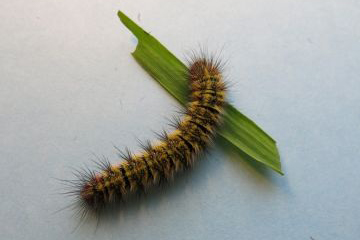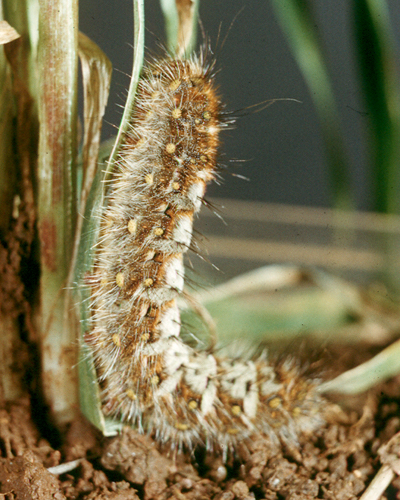Grass anthelid
Pterolocera spp.

Photo by Carol Page, CC BY-NC-SA 4.0
Summary Top
Grass anthelid is a strikingly hairy caterpillar that feeds on grasses and can damage all cereals. Larvae often feed on grasses and numbers usually build up in pastures; consequently inspect the edges of susceptible paddocks of cereal crops. It is considered a minor, restricted and irregular pest widely distributed across southern Australia.
Associated with roadside vegetation or neighbouring pastures and can move into crops in late winter/early spring.
Occurrence Top
The grass anthelid is a widely distributed Lepidopteran native to Australia and found in South Australia, Victoria, New South Wales, Tasmania and Western Australia. It is considered a minor and restricted pest that occurs irregularly.
Description Top
Larvae of this genus are sometimes called “woolly bear caterpillars”. They are brown with black, fawn and yellow markings and covered with tufts of stout hairs. The hairs can sometimes cause skin irritation. They can grow to 50 mm in length. Male moths are buff fawn with brown markings and have large feathered antennae and a wingspan of 30-40 mm. Female adults are approximately 20 mm, dark brown in colour, hairy and flightless with only vestigial wings. Little is known about the taxonomy of the Pterolocera genus.


Lifecycle Top
Grass anthelids have one generation per year. Caterpillar numbers increase in winter in grasslands or pastures before invading crops. The later instar larvae are the most damaging to crops. Grass anthelid larvae spin a dark brown cocoon in a vertical shaft in the soil. The emergence exit is just below the surface in the form of a silk tube leading to the surface. Adult female moths are flightless.
Behaviour Top
In situations where anthelid densities are high, caterpillars will form a frontal band moving across a pasture leaving it completely bare behind them.
Similar to Top
Unlikely to be confused with other caterpillars that damage cereal crops because of their conspicuously hairy appearance.
Crops attacked Top
All cereals and grass pasture.
Damage Top
When grass anthelids move into the edges of cereal crops in late winter/early spring they can cause defoliation of plants.

Monitor Top
Little is known about this pest. To monitor, inspect the edges of susceptible paddocks adjacent to grasslands, pastures or roadside vegetation, especially in late winter/early spring.
Economic thresholds Top
There have been no thresholds developed.
Management options Top
Chemical
With little known about this pest, the only known control is the use of pyrethroid insecticides that provide effective control (Bailey, 2007).
Acknowledgements Top
This article was compiled by Bill Kimber (SARDI).
References/Further Reading Top
Bailey PT. 2007. Pests of field crops and pastures: Identification and Control. CSIRO Publishing, Melbourne, Australia.
Henry K, Bellati J, Umina P and Wurst M. 2008. Crop Insects: the Ute Guide Southern Grain Belt Edition. Government of South Australia PIRSA and GRDC.
| Date | Version | Author(s) | Reviewed by |
|---|---|---|---|
| January 2015 | 1.0 | Bill Kimber (SARDI) | Garry McDonald (cesar) |
What are PestNotes?
PestNotes are information sheets developed through a collaboration between Cesar Australia and the South Australian Research and Development Institute (SARDI). Copyright: © All material published in PestNotes is copyright protected by Cesar Australia and SARDI and may not be reproduced in any form without written permission from both agencies.
Disclaimer
The material provided in PestNotes is based on the best available information at the time of publishing. No person should act on the basis of the contents of this publication without first obtaining independent, professional advice. PestNotes may identify products by proprietary or trade names to help readers identify particular products. We do not endorse or recommend the products of any manufacturer referred to. Other products may perform as well as or better than those specifically referred to. Cesar Australia and PIRSA will not be liable for any loss, damage, cost or expense incurred or arising by reason of any person using or relying on the information in this publication. Any research with unregistered pesticides or products referred to in PestNotes does not constitute a recommendation for that particular use.

